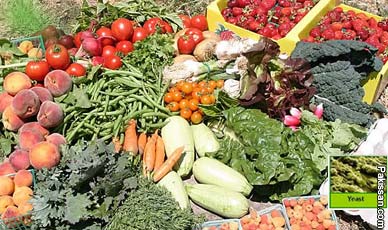|
Main Page
|
![]() |
Advantages of compost in crops farming
 THE
use of inorganic fertilisers has considerably increased
with the cultivation of exhaustive crops in the backdrop
of green revolution. Despite that, hundred of thousand
of cultivated fields have become unproductive due to
depletion of nutrients essential for plant growth and
development. Not to speak of macro-nutrient deficiency
even micro nutrients has been reported in different
fields of Punjab and Sindh. THE
use of inorganic fertilisers has considerably increased
with the cultivation of exhaustive crops in the backdrop
of green revolution. Despite that, hundred of thousand
of cultivated fields have become unproductive due to
depletion of nutrients essential for plant growth and
development. Not to speak of macro-nutrient deficiency
even micro nutrients has been reported in different
fields of Punjab and Sindh.
Off-take of fertiliser has increased from 18.9 million
nutrients in 1990-91 to 29.8 million nutrient tons in
2005-06 while cropped area has also been increased from
21 million hectares to 23 million hectares during the
same period. Fertiliser requirements are met partly from
domestic production and partly from imports. Though
off-take of fertilisers is on increase yet domestic
fertiliser production is on decline. Domestic production
has decreased from 2.28 million nutrient tons in 2001-02
to 2.13 million nutrient tons in 2005-06. On the other,
import has increased from 0.62 million nutrient tons to
around one million nutrient tons during the same period.
With the increase in off-take of fertilisers, the crop
productivity has also increased significantly but
excessive use of fertilisers has augmented the cost of
production and incidence of insect, pest and disease
attacks. Excessive use of DAP is destroying the under
soil of the farm land, increasing compaction of soils
and enhancing level of acidity of cultivated soils.
Moreover, fertiliser use efficiency is low in the
backdrop of huge nutrient losses in the form of
leaching, de-nitrification, volatilisation,
immobilisation and fixation of nutrients with soil
complex and hence contributing to soil, water and air
pollution.
Therefore, it is appropriate to look forward to those
techniques that on one hand add nutrients into soil and
improve soil texture, structure, organic matter and
water holding capacity on the other. To achieve the
desired objectives, the agricultural scientists are
pressing hard of switching to compost farming.
Application of compost is very useful as it utilises the
farm garbage and wastes in an effective way. Moreover,
100 kg compost contains 1.34 kg nitrogen, 1.3 kg
phosphorous, 1.04kg potash and 0.89kg calcium
respectively. Therefore, the growers should give due
importance to the production and use of compost.
Preparation of compost is easier and raw material comes
from agricultural farms not from the market. Different
type of crop residues such as wheat straw, rice straw,
leaves, cattle dung & urine, and other household garbage
could be effectively used for preparing compost. Simply,
these are put into a trench with adequate moisture.
Trench is 3-3.5 feet deep and length and width depends
upon the availability of organic matter. A trench of 25
feet long, 3-3.5 feet deep and four feet wide is
recommended for small farm containing 5-6 animals.
However a trench 35-40 feet long, seven feet deep and
3-3.5 feet wide is recommended for big farms. The
microbes like bacteria and fungi convert the organic
matter into compost. The microbes utilise 10 parts
carbon and only one part of nitrogen for their growth.
However, action of fungi is more efficient than
bacteria. In this process, gases like methane, ammonia,
carbon dioxide hydrogen are produced that could be
effectively utilised for energy purposes. Only draw back
in producing compost is that it is slow process and
completes in 3-5 months.
Size and mixing of crop residues also influence timing
of compost formation. Microbes thrive better on
particles having size 5cm or less. Maintaining the C:N
ratio is crucial. It could be done by mixing legume crop
residues, water hyacinth, butcher-house waste, sewerage
sludge, biogas slurry. In the case of high C:N ratio, we
can mix soil to produce a good compost. Best moisture
for compost formation ranges between 50-60 per cent.
High temperature is inevitable for the activity of the
microbes because it kills disease causing
micro-organisms and weed seeds. In case moisture is less
than 40 per cent, the process of compost formation will
be extremely slow. To speed up the process, it is
important to invert the organic matter frequently.
Inoculation is important to enhance the activity of
nitrogen-fixing fungi like penicellium and aspergillus
and bacteria such as azotobactor. Inoculation is
effective when temperature of the medium ranges between
30-35 centigrade. Inoculation is done to reduce the
period of compost formation from 3-4 months to 4-6
weeks. This also enhances amount of nitrogen up to
10-30per cent.
Use of calcium phosphate reduces time of compost
formation as well as enhances nitrogen uptake. During
compost formation, it is essential to destroy the
disease causing agents especially when sewerage sludge
is mixed in the organic matter.
Well-pulverised compost adds more nutrients to the soil
and within a short span of time. It improves soil
texture, structure, oxygen diffusion ratio, pore space,
water holding capacity and plant resistance against
lodging and microbial activity.
Compost is suitable for all kinds of crops including
cereals, vegetable, oilseeds, fruits and flowers. About
15-20 carts per acre in irrigated and 5-10 carts per
acre in rain-fed areas are recommended. Compost enhances
uptake of inorganic fertilisers by crop plants.
It is advisable for the farmers to assemble animal dung
and wasted straw for compost preparation. Addition of
compost into soil will cut the use of artificial
fertiliser, conserve soil and water, improve physical
health of soil, enhance fertiliser use efficiency,
improve soil fertility and ultimately enhance crop
yields.
Courtesy: The DAWN |
|
Pakissan.com;
|
|
|